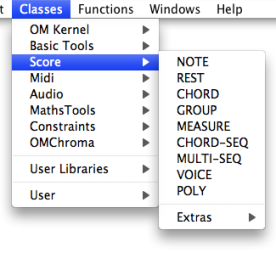Score Classes
 | Score classes enclose the musical objects that compose a score : notes , chords , chord-seqs , voices , polys , measures and groups . Out of convenience, we have gathered these objects in three categories : "harmonic", "rhythmic" and "polyphonic" objects. They can be accessed via the |
Types : "Harmonic", "Rhythmic" and "Polyphonic" Objects.
-
Harmonic objects include three classes : notes , chords and chord-seqs .
-
Rhythmic objects include
- one main class : voices,
- and two complementary classes : groups and measures .
-
Polyphonic objects include : polys and multi-seqs . These are "superimpositions" of objects :
- voices on one hand,
- chord-seqs on the other hand.
Time Representation

These objects can be classified into two temporal categories :
- Pulsed, or rhythmic representations are based on a traditional rhythmic expression of events in time, via rhythm trees1. Voices , polys , groups and measures are pulsed representations.
- Linear representations are based on the absolute duration of events – in milliseconds. Chord-seqs and multi-seqs are linear representations.
- Notes and chords are transverse to both temporal categories.
- Rhythm Tree
A rhythm tree expresses a rhythmic structure as a list. We use the term of "tree" because this structure is alike a tree structure.
This list has :
-
a duration, or number of measures,
-
a time signature,
-
a list or proportions, or rhythmic values.
For instance : (1 ((4//4 (1 1 1 1))) means one measure, four beats time signature, four whole notes.
-
